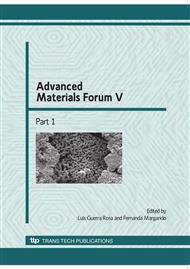p.624
p.631
p.637
p.643
p.651
p.657
p.665
p.671
p.676
A Study of Point Defects in the B2-Phase Region of the Fe-Al System by Mössbauer Spectroscopy
Abstract:
In this work, Mössbauer spectroscopy and X-ray powder diffraction (XRD) are used in a study of point defect formation in intermetallic phases of the B2 structure of the Fe-Al system as a function of Al concentration. The results are compared with the concentrations of point defect determined from positron annihilation data. In the Mössbauer effect, two types of samples are investigated: Fe-Al alloys with few additives obtained by induction melting and Al-rich metallic powders produced by the self-decomposition method and intensive grinding of high energy in the electro-magneto-mechanical mill. The work presents the values of the 57Fe isomer shift and quadruple splitting for the components describing the point defect in the local environment of a Mössbauer nuclide. The concentration of the Fe vacancies and Fe atoms substituting Al (Fe-AS) are determined. The results show that an increase in Al content causes an increase in vacancy and Fe-AS concentration.
Info:
Periodical:
Pages:
651-656
Citation:
Online since:
January 2010
Authors:
Keywords:
Price:
Сopyright:
© 2010 Trans Tech Publications Ltd. All Rights Reserved
Share:
Citation:


